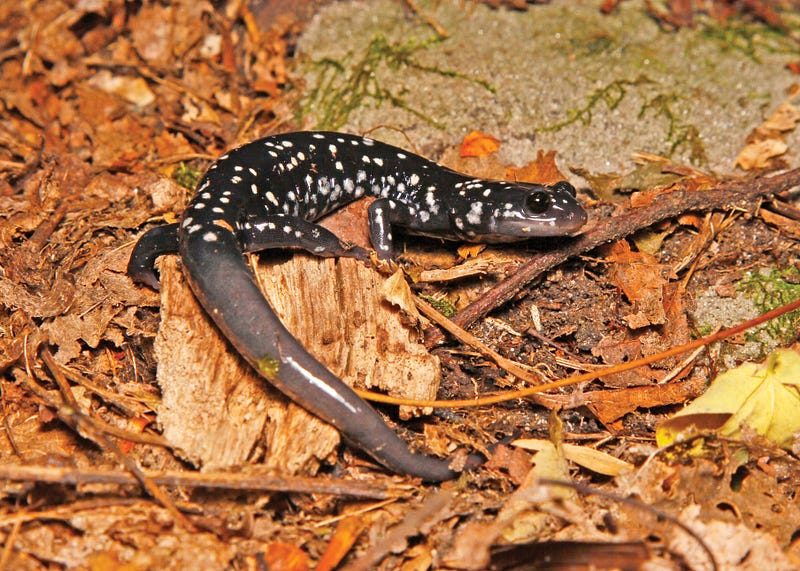Meghan Doran, Community Engagement Manager
Marlo Perdicas, Park Biologist

Spotted. Long-tailed. Slimy. Four-toed. These words sound like the names of aliens, or creatures from a different planet. In fact, they are not! Salamanders, like the spotted, appear to be otherworldly. Summit Metro Parks boasts 13 colorful species of salamanders.
They thrive in all different habitats, from the stunning ledges of Liberty Park (Twinsburg) to the swampy lowlands of the Clinton Area along the Towpath Trail. They can also be found in streams and the forest floor of our other natural areas. Salamanders in Ohio belong to two different families: one with lungs (mole salamanders) and one that breathes only through their skin (lungless salamanders).
You may be asking yourself, “Why should I care about these slimy critters?” Salamanders are one of the largest group of animals to provide food for many other creatures in the forest including birds, mammals and even larger amphibians. Turn over a log in the forest and watch for just a few moments. You will see an entire food web just before your eyes, where mini crustaceans (pill bugs) are living among major predators, such as the spotted salamander. These voracious predators spend most of their lives underground, like a mole, hiding in the darkness.


Mole salamanders, including spotted, Jefferson and small-mouthed salamanders go unnoticed by most visitors. One of our area’s most-loved events of the spring is the amphibian migration, where these giants emerge to make the journey to breeding pools to continue their life cycle. Though we are no longer hosting these programs for the safety of the animals, many visitors have enjoyed these opportunities over the years in Summit Metro Parks and have been inspired to begin their own journey of finding more knowledge and appreciation for these fascinating animals.
Salamanders can be found in each Metro Park and in a variety of habitats. Liberty Park, with 3,000 acres of high-quality and restored wetlands, pristine ledges, and streams, is a salamander’s paradise. Each species found in Liberty Park has very specific habitat requirements. Moss hummocks, moisture, darkness and plenty of food are necessary for the long-tailed salamander.
Just down the way, restored wetlands that are home to prehistoric-looking ferns and hummocks make way for families of the four-toed salamander, a species of concern in Ohio. Animals and plants listed as species of concern or threatened are on the brink of drastic decline, usually due to habitat loss. Therefore, protecting and preserving places like Liberty Park and other Summit Metro Parks are crucial to their success.

Conservation Efforts
One of the ways that SMP protects and conserves our natural resources is by collecting data from salamander “Citizen Science” surveys conducted by trained volunteers supervised by park district staff. At Liberty Park, we had a unique opportunity to inventory and monitor terrestrial salamanders before and after the park was developed.
The staff were interested in knowing if the development of trails affected the salamanders living on the forest floor and in the rock ledges. Marlo Perdicas, biologist for Summit Metro Parks, has been leading this project since 2006. “More than a decade later and after many volunteer hours, we have found that diversity and number of salamanders is stable, despite public trails throughout the park,” reports Perdicas.

Through research, park inventories, educational programs and more, we hope that visitors can experience the wonder and joy of seeing one of these colorful creatures. More importantly, we hope that you will appreciate these interesting animals and help us protect salamanders by observing them with your eyes and cameras only. Remember that because they get oxygen through their skin, anything that is on our hands can be of great detriment to their survival. We invite you to join a naturalist on a hike or at a virtual park program to learn more!
For more stories like this, check out Green Islands Magazine, a bi-monthly publication from Summit Metro Parks. Summit County residents can sign up to receive the publication at home free of charge.